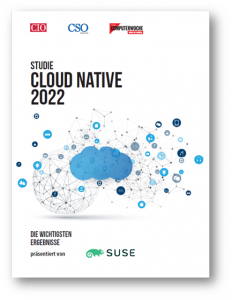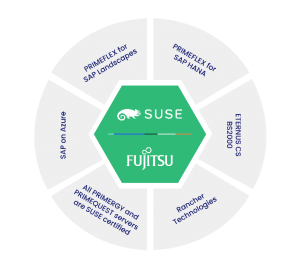Technological innovations are often considered to be ideas and solutions that take off immediately. But the evolution of Linux tells a different story: From humble beginnings in the 1990s, Linux has grown slowly and steadily to become a leading operating system in the business world, and now a business-critical operating system to run SAP. During this time, Fujitsu and SUSE have continued to innovate together, helping businesses everywhere to realize the benefits of Linux by running their SAP applications on it. I caught up with Jürgen Ellwanger and Martin Werner at the Global Fujitsu SAP Competence Centre to find out more about how Fujitsu and SUSE supported the evolution of Linux through a partnership of collaboration and innovation.
The Beginnings of Linux
In the 1990s the idea of a fully open-source and free operating system was still novel, with proprietary UNIX solutions like AIX, HP-UX, Ultrix, Sinix, etc. forming the basis for most operating systems. The arrival of the open-source OS Linux, created in 1991 by Linus Torvalds, a student, at the University of Helsinki, changed the situation fundamentally, but it was slow in the beginning. Despite being highly acclaimed by IT experts it was not until the late 1990s that the IT community started to realise the opportunities presented by Linux.
In 1999, SAP founded the SAP Linux Lab in Waldorf and both Fujitsu and SUSE became founding members. As early adopters, both Fujitsu and SUSE recognized the potential of Linux OS, and it was Fujitsu that gained the first published official SAP benchmark on Linux in 1999. Back then, the importance of Linux was still small compared to proprietary solutions, as IT manufacturers continued to favor more traditional OS.
Providing enterprise support for the mission-critical SAP solutions was a major issue, where Fujitsu and SUSE worked jointly to be able to offer the demanded quality.
However, also the technical facts had to be proven. So, Fujitsu not only did the first SAP SD benchmark on Linux but also delivered a remarkable track record of World Records in SAP benchmarking for Linux in the last decades.
Fast-forward to today and the entire SAP strategy is evolving to Linux with 70% of all business-critical SAP applications on Linux. Jürgen Ellwanger elaborates, “Every year, Linux has taken a big step forward on every level; robustness, mission-critical approach, scalability and performance everywhere. And as a result, all the development from SAP has been on Linux. Nothing else anymore. That’s a real success story there.”
Innovating Together for Success
Together, Fujitsu and SUSE have continued to lead the way on Linux. A couple of highlights of this are:
- Based on the jointly with SAP and SUSE invented Adaptive Computing concept, Fujitsu developed the FlexFrame concept, which was a breakthrough in efficient and flexible operations of the SAP data center with many ideas implemented which we today find in “Cloud” operations.
- Design, development, and certification of the first business warehouse application on SAP HANA – of course, based on SUSE Linux.
For both inventions, Fujitsu was awarded the SAP Pinnacle Award as “Innovator of the year”. Fujitsu continues to innovate around SAP, working with SUSE and other partners to develop innovative solutions that work for their customers. “At the Global Fujitsu SAP Competence Center we work with our partners’ expertise, and pair that with our experience in mission-critical customer projects, to not only make things work but to do it in a way that can be automated, easy to manage, easy to operate and flexible, in a cost-efficient way,” explained Jürgen. A great example of this is the Fujitsu Reference Architecture for SAP Data Intelligence running on Linux – read more about this fascinating story here.
Kubernetes on Linux
One might say that the latest step in the evolution of Linux is the development of containerized architecture. Containers are a key component in digital transformation, providing agility in how applications are built, deployed, and managed. Kubernetes allows the management of multiple containers for flexibility and scalability across the IT infrastructure. But when SUSE acquired Rancher, the most widely adopted Kubernetes Platform, in 2020, the special relationship of innovation between Fujitsu and SUSE met a new challenge.
With Rancher, the previous Containers-as-a-Service platform on which the reference architecture for SAP Data Intelligence was built, was set to end-of-sales immediately and this was what the Fujitsu SAP Competence Center had been using. Once again, the Linux Lab was put to the test, bringing together the partners to share, discuss and innovate together. In the end, the technology from Rancher has made the partnership even stronger and more robust, providing more opportunities to develop new solutions for customers.
Martin Werner commented on the success of the collaboration, “I think for both of the partners [SUSE and Fujitsu], continuous communication was important. Rancher brought a huge amount of experience in Kubernetes, we [Fujitsu] brought our SAP experience, along with the SAP experience coming from SUSE. Together we have created an SAP eco-system with the security, availability, speed, and reliability that our customers need and expect.”
The evolution of Linux is an incredible success story on its own. But Fujitsu and SUSE have also had a part to play in that. Innovating together for over twenty years, to ensure Linux is the SAP operating system of choice. In the words of Jürgen Ellwanger, “Still today, the Linux Lab is where we have our core meetings, sharing what we are doing, providing suggestions or proposals for anything that we could change or improve. And that is what makes this partnership so successful.”
If you would like to find out more click here.




 January is always a month for tech predictions. I cooked up a few of my own, in the main areas SUSE’s technology and solutions intersects with. So here’s my little list.
January is always a month for tech predictions. I cooked up a few of my own, in the main areas SUSE’s technology and solutions intersects with. So here’s my little list.


